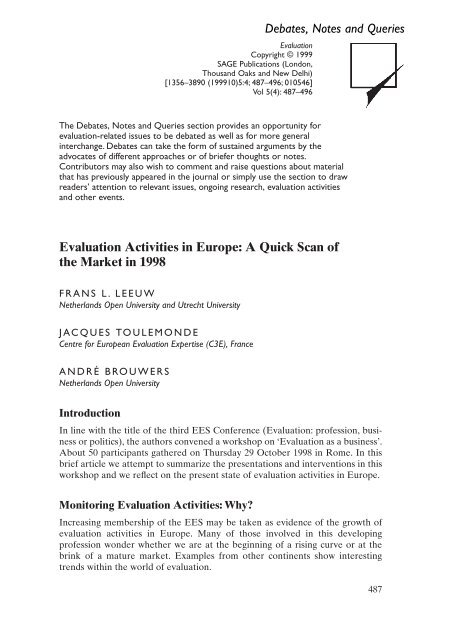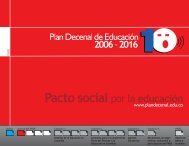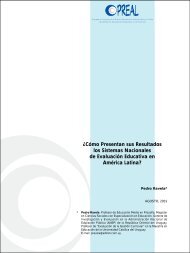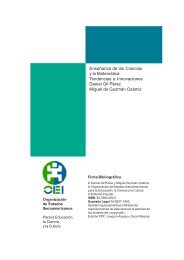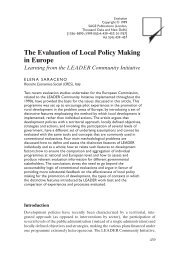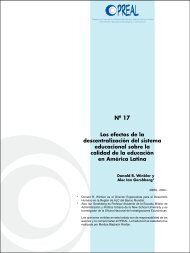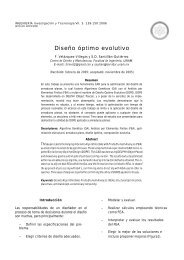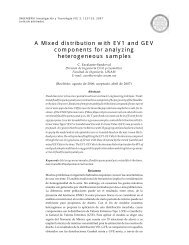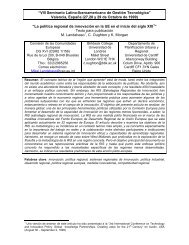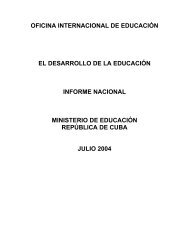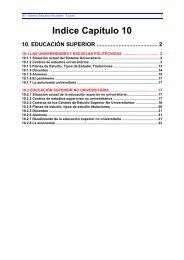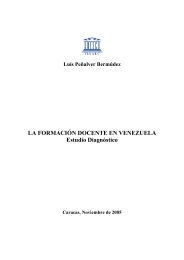Evaluation Activities in Europe: A Quick Scan of the Market in ... - OEI
Evaluation Activities in Europe: A Quick Scan of the Market in ... - OEI
Evaluation Activities in Europe: A Quick Scan of the Market in ... - OEI
Create successful ePaper yourself
Turn your PDF publications into a flip-book with our unique Google optimized e-Paper software.
<strong>Evaluation</strong><br />
Copyright © 1999<br />
SAGE Publications (London,<br />
Thousand Oaks and New Delhi)<br />
[1356–3890 (199910)5:4; 487–496; 010546]<br />
Vol 5(4): 487–496<br />
Debates, Notes and Queries<br />
The Debates, Notes and Queries section provides an opportunity for<br />
evaluation-related issues to be debated as well as for more general<br />
<strong>in</strong>terchange. Debates can take <strong>the</strong> form <strong>of</strong> susta<strong>in</strong>ed arguments by <strong>the</strong><br />
advocates <strong>of</strong> different approaches or <strong>of</strong> briefer thoughts or notes.<br />
Contributors may also wish to comment and raise questions about material<br />
that has previously appeared <strong>in</strong> <strong>the</strong> journal or simply use <strong>the</strong> section to draw<br />
readers’ attention to relevant issues, ongo<strong>in</strong>g research, evaluation activities<br />
and o<strong>the</strong>r events.<br />
<strong>Evaluation</strong> <strong>Activities</strong> <strong>in</strong> <strong>Europe</strong>: A <strong>Quick</strong> <strong>Scan</strong> <strong>of</strong><br />
<strong>the</strong> <strong>Market</strong> <strong>in</strong> 1998<br />
FRANS L. LEEUW<br />
Ne<strong>the</strong>rlands Open University and Utrecht University<br />
JACQUES TOULEMONDE<br />
Centre for <strong>Europe</strong>an <strong>Evaluation</strong> Expertise (C3E), France<br />
ANDRÉ BROUWERS<br />
Ne<strong>the</strong>rlands Open University<br />
Introduction<br />
In l<strong>in</strong>e with <strong>the</strong> title <strong>of</strong> <strong>the</strong> third EES Conference (<strong>Evaluation</strong>: pr<strong>of</strong>ession, bus<strong>in</strong>ess<br />
or politics), <strong>the</strong> authors convened a workshop on ‘<strong>Evaluation</strong> as a bus<strong>in</strong>ess’.<br />
About 50 participants ga<strong>the</strong>red on Thursday 29 October 1998 <strong>in</strong> Rome. In this<br />
brief article we attempt to summarize <strong>the</strong> presentations and <strong>in</strong>terventions <strong>in</strong> this<br />
workshop and we reflect on <strong>the</strong> present state <strong>of</strong> evaluation activities <strong>in</strong> <strong>Europe</strong>.<br />
Monitor<strong>in</strong>g <strong>Evaluation</strong> <strong>Activities</strong>: Why?<br />
Increas<strong>in</strong>g membership <strong>of</strong> <strong>the</strong> EES may be taken as evidence <strong>of</strong> <strong>the</strong> growth <strong>of</strong><br />
evaluation activities <strong>in</strong> <strong>Europe</strong>. Many <strong>of</strong> those <strong>in</strong>volved <strong>in</strong> this develop<strong>in</strong>g<br />
pr<strong>of</strong>ession wonder whe<strong>the</strong>r we are at <strong>the</strong> beg<strong>in</strong>n<strong>in</strong>g <strong>of</strong> a ris<strong>in</strong>g curve or at <strong>the</strong><br />
br<strong>in</strong>k <strong>of</strong> a mature market. Examples from o<strong>the</strong>r cont<strong>in</strong>ents show <strong>in</strong>terest<strong>in</strong>g<br />
trends with<strong>in</strong> <strong>the</strong> world <strong>of</strong> evaluation.<br />
487
<strong>Evaluation</strong> 5(4)<br />
In <strong>the</strong> United States, General Account<strong>in</strong>g Office (GAO) reports (1987, 1998)<br />
show that <strong>the</strong> support for and use <strong>of</strong> programme evaluation <strong>in</strong> both <strong>the</strong> executive<br />
and legislative branches has ‘unmistakenly decl<strong>in</strong>ed’ (Paliokas and Rist, 1998).<br />
Compared to <strong>the</strong> l960s ‘golden years’ <strong>of</strong> evaluation that Rossi and Wright (1984:<br />
332) referred to and to <strong>the</strong> 1980s, when GAO’s PEMD (Programme <strong>Evaluation</strong><br />
and Methodology Division) had its f<strong>in</strong>est hours, th<strong>in</strong>gs have changed. At <strong>the</strong> same<br />
time, evaluation seems to have survived as rout<strong>in</strong>ely accepted activity <strong>in</strong> many<br />
departments, states, local authorities and NGOs.<br />
In Australia, <strong>the</strong> annual number <strong>of</strong> evaluation reports jumped from almost zero<br />
to hundreds between 1985 and 1995. The high political commitment <strong>in</strong> favour <strong>of</strong><br />
evaluation has now fallen back, but <strong>the</strong> overall level <strong>of</strong> activity seems to be steady<br />
(MacKay, 1998).<br />
In <strong>Europe</strong>, susta<strong>in</strong>ed attention has been paid to evaluation activities (Summa<br />
and Toulemonde, 1998). A recent survey <strong>in</strong> <strong>the</strong> field <strong>of</strong> socio-economic development<br />
policies shows that <strong>the</strong> evaluation market has developed remarkably dur<strong>in</strong>g<br />
<strong>the</strong> past five years, as have <strong>the</strong> number <strong>of</strong> agents perform<strong>in</strong>g evaluation work<br />
(EC-DG XVI, forthcom<strong>in</strong>g). Data on <strong>the</strong> Ne<strong>the</strong>rlands also show a strong <strong>in</strong>crease<br />
<strong>in</strong> <strong>the</strong> number <strong>of</strong> (ex post) evaluations carried out by central government departments<br />
when <strong>the</strong> mid 1990s are compared to <strong>the</strong> late 1980s (Leeuw and Rozendal,<br />
1994; Leeuw, 1997).<br />
The supply <strong>of</strong> evaluation services <strong>of</strong>ten rema<strong>in</strong>s external to adm<strong>in</strong>istrations.<br />
The number <strong>of</strong> consultancy firms active <strong>in</strong> <strong>the</strong> field <strong>of</strong> evaluation has risen sharply<br />
<strong>in</strong> all countries. Entrust<strong>in</strong>g evaluation to outside evaluators, whe<strong>the</strong>r private consultants<br />
or universities, is seen as a guarantee <strong>of</strong> <strong>the</strong> <strong>in</strong>dependence <strong>of</strong> <strong>the</strong> team <strong>in</strong><br />
relation to <strong>the</strong> authorities or pr<strong>in</strong>cipals concerned. This sector has developed <strong>in</strong><br />
different ways: <strong>the</strong> emergence <strong>of</strong> teams l<strong>in</strong>ked to <strong>the</strong> academic world and <strong>the</strong> creation<br />
<strong>of</strong> departments or subsidiaries <strong>of</strong> <strong>in</strong>ternational consultancy groups. The<br />
quantitative development <strong>of</strong> supply is also accompanied by qualitative developments<br />
generated by greater pr<strong>of</strong>essionalism. Skills have also evolved <strong>in</strong> recent<br />
years, ow<strong>in</strong>g more to accumulated experience than to <strong>the</strong> specialization <strong>of</strong> evaluation<br />
service suppliers.<br />
A glance at <strong>the</strong>se contrasted trends <strong>in</strong> various parts <strong>of</strong> <strong>the</strong> globe suggests that<br />
<strong>the</strong> ups and downs <strong>of</strong> evaluation activities would deserve to be more carefully<br />
monitored, and hopefully expla<strong>in</strong>ed.<br />
Monitor<strong>in</strong>g <strong>Evaluation</strong> <strong>Activities</strong>: How?<br />
There are several ways to monitor growth (or decl<strong>in</strong>e) <strong>of</strong> evaluation activities.<br />
A first way <strong>of</strong> monitor<strong>in</strong>g trends is to survey <strong>the</strong> activities <strong>of</strong> commissioners,<br />
with questions like:<br />
• To what extent do policy makers, politicians and practitioners make use <strong>of</strong><br />
evaluations <strong>in</strong> <strong>the</strong>ir decisions? Research look<strong>in</strong>g <strong>in</strong>to <strong>the</strong> utilization <strong>of</strong> evaluations<br />
<strong>of</strong>ten follows this route;<br />
• How many organizations (public, private or hybrid) are carry<strong>in</strong>g out evaluations<br />
as a permanent activity?<br />
• Why do adm<strong>in</strong>istrations <strong>in</strong> some countries adopt evaluation earlier than<br />
488
o<strong>the</strong>r countries? In <strong>the</strong> past, <strong>in</strong>ternational observers have identified several<br />
waves <strong>of</strong> evaluation development, correspond<strong>in</strong>g to different political<br />
demands (Derlien, 1990).<br />
A second way consists <strong>in</strong> count<strong>in</strong>g evaluation reports across client <strong>in</strong>stitutions.<br />
As far as we know, only a few databases <strong>of</strong> evaluation reports have been fully<br />
operational (e.g. <strong>in</strong> <strong>the</strong> Australian Department <strong>of</strong> F<strong>in</strong>ance and <strong>the</strong> Treasury<br />
Board <strong>of</strong> Canada). This approach is probably only workable <strong>in</strong> a ra<strong>the</strong>r centralized<br />
evaluation system that depends heavily on a lead<strong>in</strong>g <strong>in</strong>stitution. S<strong>in</strong>ce evaluation<br />
activities <strong>in</strong>creas<strong>in</strong>gly permeate all layers <strong>of</strong> adm<strong>in</strong>istrations and all levels<br />
<strong>of</strong> governments, evaluation databases may become unmanageable. Bibliometrics<br />
could be an <strong>in</strong>terest<strong>in</strong>g substitute, if corrected by surveys look<strong>in</strong>g at differences<br />
<strong>in</strong> publish<strong>in</strong>g behaviour across <strong>Europe</strong>an countries.<br />
In a third approach, one could ga<strong>the</strong>r <strong>in</strong>direct evidence about evaluation trends<br />
through repeatedly tak<strong>in</strong>g stock <strong>of</strong> teach<strong>in</strong>g and tra<strong>in</strong><strong>in</strong>g programmes. The<br />
number <strong>of</strong> programmes and students could be counted, as well as <strong>the</strong> evaluation<br />
content <strong>of</strong> <strong>the</strong> curricula (Is evaluation a m<strong>in</strong>or/major component <strong>in</strong> <strong>the</strong> programme?<br />
Does <strong>the</strong> programme focus on evaluation <strong>the</strong>ory/practice?).<br />
In prepar<strong>in</strong>g <strong>the</strong> EES Conference, we have followed a fourth way which is to<br />
survey <strong>the</strong> activities <strong>of</strong> evaluation service providers, both private sector consultants<br />
and academic research centres (see Box 1).<br />
One or Several <strong>Market</strong>s <strong>in</strong> <strong>Europe</strong>?<br />
Leeuw et al.: <strong>Evaluation</strong> <strong>Activities</strong> <strong>in</strong> <strong>Europe</strong><br />
Participants <strong>in</strong> <strong>the</strong> EES workshop <strong>in</strong> Rome acknowledged that many evaluators<br />
concentrate on a given policy doma<strong>in</strong> and use evaluation methods and skills that<br />
are specific to <strong>the</strong>ir field. This was highlighted by one respondent <strong>in</strong> <strong>the</strong> follow<strong>in</strong>g<br />
terms:<br />
<strong>Evaluation</strong> criteria and methods used <strong>in</strong> country-wide or sectoral evaluations <strong>of</strong> aid<br />
programmes are still far from hav<strong>in</strong>g led to commonly accepted def<strong>in</strong>itions and rules,<br />
even with<strong>in</strong> <strong>the</strong> EU.... Methods have still to be improved but above all an ongo<strong>in</strong>g<br />
process <strong>of</strong> updat<strong>in</strong>g and harmonis<strong>in</strong>g def<strong>in</strong>itions and methods [is important].<br />
<strong>Evaluation</strong> activities <strong>in</strong> <strong>Europe</strong> seem even more fragmented when we look at<br />
national (sub)markets. One can easily understand that foreign evaluators face<br />
high barriers when try<strong>in</strong>g to enter <strong>in</strong>to a given national market, especially for<br />
reasons <strong>of</strong> language, knowledge <strong>of</strong> <strong>in</strong>stitutional sett<strong>in</strong>gs and familiarity with<br />
adm<strong>in</strong>istrative culture. A participant <strong>in</strong> <strong>the</strong> workshop stressed that it was even<br />
hard to hire an English evaluator <strong>in</strong> Ireland, although <strong>the</strong> pool <strong>of</strong> qualified<br />
national consultants is small <strong>in</strong> <strong>the</strong> latter country.<br />
When it comes to evaluat<strong>in</strong>g <strong>Europe</strong>an-wide policies, this fragmented supply<br />
creates a problem. The <strong>Europe</strong>an Commission can barely f<strong>in</strong>d enough genu<strong>in</strong>ely<br />
<strong>Europe</strong>an suppliers. Many tenders and contracts <strong>in</strong>volve ad hoc consortia<br />
merg<strong>in</strong>g with national evaluators. We may be see<strong>in</strong>g <strong>the</strong> development <strong>of</strong> a<br />
new (quasi)-pr<strong>of</strong>ession, which consists <strong>of</strong> ga<strong>the</strong>r<strong>in</strong>g a dozen national evaluators,<br />
<strong>of</strong> mak<strong>in</strong>g <strong>the</strong>m evaluate a given <strong>Europe</strong>an policy from various national standpo<strong>in</strong>ts,<br />
and <strong>in</strong> work<strong>in</strong>g hard to draw syn<strong>the</strong>tic conclusions for use at <strong>the</strong><br />
489
<strong>Evaluation</strong> 5(4)<br />
Box 1 – A small survey <strong>of</strong> <strong>Europe</strong>an evaluators<br />
EES headquarters <strong>in</strong> Stockholm mailed 518 questionnaires to people and<br />
organizations <strong>in</strong> 15 countries (all EU member states m<strong>in</strong>us Luxembourg,<br />
plus Switzerland). Addressees belonged to one or several <strong>of</strong> <strong>the</strong> follow<strong>in</strong>g<br />
lists:<br />
• evaluation experts hav<strong>in</strong>g answered <strong>the</strong> call for expression <strong>of</strong> <strong>in</strong>terest<br />
recently issued by <strong>the</strong> <strong>Europe</strong>an Commission (DG XIX);<br />
• consultants with<strong>in</strong> <strong>the</strong> EES membership;<br />
• consultants with<strong>in</strong> <strong>the</strong> C3E’s contact list.<br />
To an unknown extent, <strong>the</strong> mail<strong>in</strong>g list was biased <strong>in</strong> favour <strong>of</strong> evaluators<br />
deal<strong>in</strong>g with socio-economic development policies.<br />
Question 1 concerned <strong>the</strong> type <strong>of</strong> organization <strong>the</strong> respondent was affiliated<br />
with (private, not for pr<strong>of</strong>it, quasi-governmental). Question 2 focused<br />
on <strong>the</strong> total budget <strong>of</strong> <strong>the</strong> organization, while Question 3 dealt with <strong>the</strong> part<br />
<strong>of</strong> this budget that was directly related to carry<strong>in</strong>g out evaluations. Question<br />
4 tried to ga<strong>in</strong> an <strong>in</strong>sight <strong>in</strong>to a trend. We asked: ‘Compared to <strong>the</strong> early<br />
n<strong>in</strong>eties, has this proportion been stable, <strong>in</strong>creased or decreased?’ Question<br />
5 focused on what <strong>the</strong> respondents considered <strong>the</strong>ir four biggest markets for<br />
evaluations. ‘<strong>Market</strong>s’ were def<strong>in</strong>ed by cross<strong>in</strong>g policy doma<strong>in</strong>s and countries.<br />
Question 6 wanted to f<strong>in</strong>d out how <strong>the</strong> evaluation activities <strong>in</strong> <strong>the</strong><br />
respondent’s organization were divided given <strong>the</strong>se four markets, while with<br />
Question 7 we wanted to ga<strong>in</strong> some <strong>in</strong>sight <strong>in</strong>to what share <strong>the</strong> respondents’<br />
organization has <strong>in</strong> <strong>the</strong>se four markets. F<strong>in</strong>ally, we added a question allow<strong>in</strong>g<br />
<strong>the</strong> respondents to add ‘qualitative comments’ on <strong>the</strong> situation <strong>of</strong> <strong>the</strong><br />
‘evaluation market’ <strong>in</strong> <strong>Europe</strong>.<br />
The response was very limited. Only 32 <strong>of</strong> all <strong>the</strong> questionnaires were<br />
returned. This may be partly expla<strong>in</strong>ed by outdated addresses <strong>in</strong> <strong>the</strong> mail<strong>in</strong>g<br />
list. In addition, we had nei<strong>the</strong>r budget nor time for undertak<strong>in</strong>g (telephone)<br />
follow-up. Half <strong>of</strong> <strong>the</strong> 32 organizations respond<strong>in</strong>g were private (n = 16), <strong>the</strong><br />
o<strong>the</strong>r half non-pr<strong>of</strong>it (n = 8) or quasi-governmental (n = 3). Miss<strong>in</strong>g values<br />
account for <strong>the</strong> differences that appear <strong>in</strong> this paper. For <strong>the</strong> analysis we<br />
brought toge<strong>the</strong>r <strong>the</strong> non-pr<strong>of</strong>it and quasi-governmental organizations.<br />
<strong>Europe</strong>an level. Surpris<strong>in</strong>gly, most <strong>of</strong> <strong>the</strong> big audit companies also operate <strong>in</strong> a<br />
fragmented manner, as far as we speak <strong>of</strong> evaluation which is not part <strong>of</strong> <strong>the</strong>ir<br />
core bus<strong>in</strong>ess.<br />
A Fast Grow<strong>in</strong>g Bus<strong>in</strong>ess?<br />
As <strong>in</strong>dicated <strong>in</strong> Box 1, only 32 organizations responded. Most <strong>of</strong> <strong>the</strong>m (n = 25)<br />
report a growth <strong>in</strong> <strong>the</strong> proportion <strong>of</strong> <strong>the</strong>ir turn-over generated by programme and<br />
490
Leeuw et al.: <strong>Evaluation</strong> <strong>Activities</strong> <strong>in</strong> <strong>Europe</strong><br />
policy evaluations. 1 Only two organizations report a decl<strong>in</strong>e, while <strong>the</strong> five<br />
rema<strong>in</strong><strong>in</strong>g organizations report that <strong>the</strong> proportion [compared to <strong>the</strong> early 1990s]<br />
is stable. 2 This growth is stressed by one respondent <strong>in</strong> <strong>the</strong>se terms: ‘evaluation<br />
is [becom<strong>in</strong>g a] standard procedure <strong>in</strong> <strong>the</strong> policy process’. With regard to private<br />
sector organizations, 5 out <strong>of</strong> 16 have to deal with a decl<strong>in</strong>e or a stable percentage<br />
<strong>of</strong> <strong>the</strong>ir evaluation activities. This is only true for 1 (out <strong>of</strong> 11) nonpr<strong>of</strong>it/quasi-governmental<br />
organizations (see Table 1).<br />
Table 2 shows <strong>the</strong> ma<strong>in</strong> ‘operat<strong>in</strong>g fields’ ranked as follows: (1) economic<br />
development and enterprises; 3 (2) social services and health; (3) development, aid<br />
and transition, (4) education, schools and tra<strong>in</strong><strong>in</strong>g and (5) technology, <strong>in</strong>novation<br />
and research. Relatively less important are <strong>the</strong> fields <strong>of</strong> security, police, justice,<br />
agriculture and <strong>the</strong> environment.<br />
Participants <strong>in</strong> <strong>the</strong> workshop agreed that evaluation demand is develop<strong>in</strong>g<br />
faster at <strong>Europe</strong>an and national level than at regional and local level. While<br />
almost all <strong>Europe</strong>an policies are now subject to periodic evaluation, a figure <strong>of</strong><br />
10 percent was mentioned for <strong>the</strong> proportion <strong>of</strong> regional policies that are subject<br />
to periodic evaluations <strong>in</strong> countries like <strong>the</strong> UK, Denmark, <strong>the</strong> Ne<strong>the</strong>rlands and<br />
France.<br />
The questionnaire survey cannot <strong>in</strong>form us about <strong>the</strong> size <strong>of</strong> <strong>Europe</strong>an<br />
market(s). It cannot even provide us with an order <strong>of</strong> magnitude. An <strong>in</strong>terest<strong>in</strong>g<br />
figure was given by one <strong>of</strong> <strong>the</strong> workshop participants about <strong>the</strong> overall cost (<strong>in</strong>ternal<br />
and external) <strong>of</strong> runn<strong>in</strong>g a systematic evaluation function. In <strong>the</strong> case <strong>of</strong> <strong>Europe</strong>an<br />
Structural Funds <strong>in</strong> Ireland, this cost amounted to about 1 percent <strong>of</strong> <strong>the</strong><br />
total public expenses <strong>in</strong>volved (CSF <strong>Evaluation</strong> Unit, 1998).<br />
Table 3 shows <strong>the</strong> respondents’ op<strong>in</strong>ion about <strong>the</strong> share <strong>of</strong> <strong>the</strong>ir organization<br />
<strong>in</strong> <strong>the</strong>ir biggest evaluation markets. Interest<strong>in</strong>gly, <strong>the</strong>re are only five organizations<br />
<strong>in</strong>dicat<strong>in</strong>g that <strong>the</strong>ir share <strong>in</strong> ei<strong>the</strong>r one <strong>of</strong> <strong>the</strong> markets is more than 20 percent.<br />
This gives an image <strong>of</strong> an <strong>in</strong>dustry that is very far from <strong>the</strong> concentration that prevails<br />
<strong>in</strong> <strong>the</strong> ‘audit <strong>in</strong>dustry’.<br />
Figures and op<strong>in</strong>ions show a sharp growth <strong>in</strong> evaluation activities, but <strong>the</strong>y<br />
should be questioned <strong>in</strong> <strong>the</strong> light <strong>of</strong> <strong>the</strong> follow<strong>in</strong>g comments received through <strong>the</strong><br />
questionnaire survey. ‘[It is difficult] to decide how to def<strong>in</strong>e evaluations <strong>in</strong> respect<br />
<strong>of</strong> our activities, because <strong>in</strong> a sense all <strong>of</strong> our research work <strong>in</strong>volves evaluation,<br />
s<strong>in</strong>ce it assesses <strong>the</strong> current situation and tries to make recommendations for <strong>the</strong><br />
Table 1. The Nature <strong>of</strong> <strong>the</strong> Organization – Private or Not Private – By Changes <strong>in</strong><br />
Proportions <strong>of</strong> <strong>the</strong>ir Budgets Directly Related to Carry<strong>in</strong>g Out <strong>Evaluation</strong>s (Increased<br />
and Stable or Decreased); N = 27, miss<strong>in</strong>g data are not <strong>in</strong>cluded<br />
Stable or decreased Increased Total<br />
Private 5 11 16<br />
59.3 %<br />
Not private 1 10 11<br />
40.7 %<br />
Total 6 21 27<br />
22.2 % 77.8 % 100.0 %<br />
491
<strong>Evaluation</strong> 5(4)<br />
Table 2. Means (M) and Standard Deviations (SD) <strong>of</strong> Approximate Percentages <strong>of</strong> <strong>the</strong><br />
Organizations’ <strong>Evaluation</strong> <strong>Activities</strong> by Policy Doma<strong>in</strong>s, divided for Private and Not<br />
Private Organizations (N = 27, miss<strong>in</strong>g data are not <strong>in</strong>cluded)<br />
PRIVATE<br />
NOT PRIVATE<br />
(n = 16) (n = 11)<br />
M SD M SD<br />
ECON 39.4 41.4 29.5 29.5<br />
SOCIAL 12.8 26.1 12.3 16.6<br />
AID 10.3 26.4 0.9 3.0<br />
EDUC 9.4 17.3 20.0 31.9<br />
OTHER 4.4 17.5 5.0 7.1<br />
TECH 4.4 17.5 9.0 22.2<br />
AGRIC 2.5 7.7 0 0<br />
INFRA 1.9 7.5 2.7 9.0<br />
ENVIR 1.3 5.0 2.3 4.7<br />
SECUR 1.3 5.0 0 0<br />
ECON: Economic development, Enterprises; EDUC: Education, Schools, Tra<strong>in</strong><strong>in</strong>g; SOCIAL:<br />
Social Services, Health; AID: Development, Aid and Transition; TECH: Technology, Innovation,<br />
Research; INFRA: Basic Infrastructures, Transport; AGRIC: Agriculture, Fisheries, Forestry;<br />
ENVIR: Environment; SECUR: Security, Justice, Police.<br />
Table 3. Organizations’ <strong>Market</strong> Shares and Policy Doma<strong>in</strong>s<br />
1–5% 6–20% 21–100%<br />
EDUC 2 4 0<br />
SECUR 0 0 0<br />
SOCIAL 5 2 1<br />
ECON 6 4 3<br />
AGRIC 1 0 0<br />
ENVIR 1 0 1<br />
INFRA 2 0 0<br />
TECH 3 1 1<br />
AID 1 1 0<br />
OTHER 1 0 0<br />
ECON: Economic development, Enterprises; EDUC: Education, Schools, Tra<strong>in</strong><strong>in</strong>g; SOCIAL:<br />
Social Services, Health; AID: Development, Aid and Transition; TECH: Technology, Innovation,<br />
Research; INFRA: Basic Infrastructures, Transport; AGRIC: Agriculture, Fisheries, Forestry;<br />
ENVIR: Environment; SECUR: Security, Justice, Police.<br />
future’. Several participants <strong>in</strong> <strong>the</strong> workshop agreed that many studies tend to be<br />
labelled ‘evaluations’ nowadays, which would have been called action-research or<br />
organizational learn<strong>in</strong>g <strong>in</strong> <strong>the</strong> past. Reasons for <strong>the</strong>se shifts <strong>in</strong> vocabulary can be<br />
found <strong>in</strong> ei<strong>the</strong>r management fashions or <strong>the</strong> <strong>in</strong>creas<strong>in</strong>g number <strong>of</strong> rules that make<br />
evaluation compulsory. Can we rely upon our perception <strong>of</strong> an evaluation<br />
development?<br />
492
Although some perceptions are more ‘true’ than o<strong>the</strong>rs, perceptions can have<br />
a dist<strong>in</strong>ct impact on <strong>the</strong> real world. ‘If men def<strong>in</strong>e situations as real, <strong>the</strong>y are real<br />
<strong>in</strong> <strong>the</strong>ir consequences’, is an old sociological adage. The reason is that politicians,<br />
public policy makers, managers and ‘patrons <strong>of</strong> evaluation’ take societal perceptions<br />
about evaluations <strong>in</strong>to account. This happens when <strong>the</strong>y have to decide<br />
on whe<strong>the</strong>r or not to establish an evaluation capacity structure <strong>in</strong> <strong>the</strong>ir organizations,<br />
whe<strong>the</strong>r or not to commission (more) evaluations or whe<strong>the</strong>r or not to<br />
use evaluation f<strong>in</strong>d<strong>in</strong>gs. When <strong>the</strong>re is a belief that evaluations are rapidly<br />
becom<strong>in</strong>g a ‘growth <strong>in</strong>dustry’ with<strong>in</strong> <strong>the</strong> public sector, this may cause free rider<br />
behaviour by those organizational units that not yet have established such an<br />
evaluation capacity.<br />
Still an Infant Industry<br />
Leeuw et al.: <strong>Evaluation</strong> <strong>Activities</strong> <strong>in</strong> <strong>Europe</strong><br />
<strong>Evaluation</strong> can be an ‘<strong>in</strong>fant <strong>in</strong>dustry’, a ‘growth <strong>in</strong>dustry’ or an ‘<strong>in</strong>dustry <strong>in</strong><br />
decl<strong>in</strong>e’, while perceptions about <strong>the</strong> ‘<strong>in</strong>dustry’ that prevail can differ substantially.<br />
Dur<strong>in</strong>g a recent World Bank Symposium on <strong>Evaluation</strong> Capacity Build<strong>in</strong>g,<br />
Picciotto (1998) referred to programme evaluation as an ‘<strong>in</strong>fant <strong>in</strong>dustry’. An<br />
<strong>in</strong>fant <strong>in</strong>dustry <strong>in</strong> our op<strong>in</strong>ion is made up <strong>of</strong> different (small) firms simultaneously<br />
enter<strong>in</strong>g a promis<strong>in</strong>g market. This picture is <strong>in</strong> l<strong>in</strong>e with <strong>the</strong> results <strong>of</strong> our small<br />
survey. A mature market would probably be dom<strong>in</strong>ated by a few big <strong>in</strong>ternational<br />
companies, as <strong>the</strong> audit <strong>in</strong>dustry is at present.<br />
An <strong>in</strong>fant <strong>in</strong>dustry also faces problems with unstable standards, like those<br />
expressed by several respondents to our questionnaire: ‘<strong>Evaluation</strong>s are not yet<br />
fully accepted as feedback mechanisms’; ‘The evaluation process is becom<strong>in</strong>g rout<strong>in</strong>ized<br />
and simplified and de-skilled. This is a danger’. Top-down pressures <strong>in</strong><br />
favour <strong>of</strong> evaluation tend to weaken <strong>the</strong> commitment <strong>of</strong> civil servants that commission<br />
evaluations. One participant <strong>of</strong> <strong>the</strong> workshop even spoke <strong>of</strong> cynicism and<br />
asked <strong>the</strong> question whe<strong>the</strong>r demand would keep ris<strong>in</strong>g or would fall if we were<br />
no longer obliged to evaluate.<br />
Some present features <strong>of</strong> <strong>the</strong> evaluation bus<strong>in</strong>ess were po<strong>in</strong>ted out as typical<br />
<strong>of</strong> <strong>the</strong> shaky rules that govern an <strong>in</strong>fant <strong>in</strong>dustry: over-ambitious terms <strong>of</strong> reference<br />
and evaluators promis<strong>in</strong>g much more than <strong>the</strong>y are capable <strong>of</strong> deliver<strong>in</strong>g,<br />
and ambiguous requirements and behaviour with respect to <strong>in</strong>dependence.<br />
Moreover, much evaluation activity keeps focus<strong>in</strong>g on resources <strong>in</strong>stead <strong>of</strong><br />
outcomes, on adm<strong>in</strong>istrative processes <strong>in</strong>stead <strong>of</strong> social and economic stakes.<br />
There may even be a little drift <strong>in</strong>to what auditors typically do. In <strong>the</strong> UK, Mike<br />
Power (1994, 1995) referred to <strong>the</strong> ‘Audit Explosion’ and <strong>the</strong> ‘Audit Society’. He<br />
has put forward <strong>the</strong> <strong>in</strong>sight that ‘auditors become second order certifiers <strong>of</strong> <strong>the</strong><br />
form <strong>of</strong> systems ra<strong>the</strong>r than <strong>the</strong>ir substance’. He l<strong>in</strong>ks this development to <strong>the</strong><br />
knowledge base that underl<strong>in</strong>es <strong>the</strong> work <strong>of</strong> auditors and puts forward <strong>the</strong><br />
hypo<strong>the</strong>sis that ‘system audit<strong>in</strong>g is attractive because it is easier to audit <strong>the</strong><br />
system which controls a process than <strong>the</strong> outputs <strong>of</strong> that process. A drift from<br />
<strong>in</strong>spection to certification occurs when standards <strong>of</strong> control replace standards <strong>of</strong><br />
output’. 4<br />
In <strong>the</strong> longer run, <strong>the</strong>re may be a danger that if we keep call<strong>in</strong>g almost every<br />
493
<strong>Evaluation</strong> 5(4)<br />
‘policy analysis’, ‘process description’ and ‘organizational diagnosis’ an ‘evaluation’,<br />
a procedure-driven approach that resembles <strong>the</strong> current ‘audit<strong>in</strong>g<br />
approach’ (look<strong>in</strong>g <strong>in</strong>to processes <strong>in</strong>stead <strong>of</strong> outcomes for example) may be on<br />
<strong>the</strong> horizon.<br />
Help<strong>in</strong>g <strong>the</strong> <strong>Evaluation</strong> Bus<strong>in</strong>ess to Become Mature<br />
Several workshop participants took <strong>the</strong> view that evaluation activity will mature<br />
by itself through learn<strong>in</strong>g by do<strong>in</strong>g. Never<strong>the</strong>less, we th<strong>in</strong>k that evaluation<br />
societies at national and <strong>Europe</strong>an level can and should help <strong>the</strong> evaluation bus<strong>in</strong>ess<br />
to become mature. As a means <strong>of</strong> speed<strong>in</strong>g up this maturation process, we<br />
can obviously th<strong>in</strong>k <strong>of</strong> discover<strong>in</strong>g and circulat<strong>in</strong>g examples <strong>of</strong> good practice. This<br />
happened at least twice dur<strong>in</strong>g <strong>the</strong> EES Conference, as shown <strong>in</strong> Box 2.<br />
We suggest that <strong>the</strong> EES, toge<strong>the</strong>r with national evaluation societies, should<br />
cont<strong>in</strong>ue to <strong>in</strong>vestigate evaluation activities, possibly on a more permanent basis.<br />
Topical workshops could be organized <strong>in</strong> various <strong>Europe</strong>an countries under <strong>the</strong><br />
same head<strong>in</strong>g, like ‘record<strong>in</strong>g and circulat<strong>in</strong>g lessons from manag<strong>in</strong>g evaluations’.<br />
Though small, it may help.<br />
Box 2 – Two examples <strong>of</strong> <strong>in</strong>terest<strong>in</strong>g bus<strong>in</strong>ess practices<br />
These ideas have emerged <strong>in</strong> <strong>the</strong> debates dur<strong>in</strong>g <strong>the</strong> EES Conference.<br />
A Dutch evaluation commissioner records those consultants that fail to<br />
meet <strong>the</strong>ir commitments, which is taken <strong>in</strong>to account <strong>in</strong> award<strong>in</strong>g future<br />
tenders.<br />
A Belgian evaluator streng<strong>the</strong>ns his own <strong>in</strong>dependence by hav<strong>in</strong>g several<br />
<strong>in</strong>terim reports successively validated by <strong>the</strong> client. Report 1 displays <strong>the</strong><br />
<strong>in</strong>formation basis that will support <strong>the</strong> whole evaluation. Report 2 shows <strong>the</strong><br />
analyses and conclusions. Report 3 (f<strong>in</strong>al) <strong>in</strong>cludes recommendations. Once<br />
one report is validated, it cannot be questioned aga<strong>in</strong>, even if <strong>the</strong> follow<strong>in</strong>g<br />
reports <strong>in</strong>clude statements that are not welcome.<br />
Notes<br />
1. Needless to say that <strong>the</strong>re is always <strong>the</strong> possibility that respondents that do not<br />
encounter ‘growth’ belong to <strong>the</strong> non-respondents.<br />
2. For fur<strong>the</strong>r analysis we brought toge<strong>the</strong>r organizations with decl<strong>in</strong><strong>in</strong>g market shares<br />
and organizations with stable market shares for perform<strong>in</strong>g evaluations (labelled ‘stable<br />
or decreased’).<br />
3. This first rank<strong>in</strong>g may result from a bias <strong>in</strong> <strong>the</strong> mail<strong>in</strong>g list.<br />
4. This love for systems has also been found <strong>in</strong> <strong>the</strong> comparative study <strong>of</strong> <strong>the</strong> OECD’s<br />
Public Management Group. OECD-PUMA has <strong>in</strong>ventorized developments and consequences<br />
<strong>of</strong> audit<strong>in</strong>g <strong>in</strong> some <strong>of</strong> <strong>the</strong>ir member states.<br />
494
References<br />
Leeuw et al.: <strong>Evaluation</strong> <strong>Activities</strong> <strong>in</strong> <strong>Europe</strong><br />
CSF <strong>Evaluation</strong> Unit (1998) Review <strong>of</strong> Ongo<strong>in</strong>g <strong>Evaluation</strong> Function <strong>in</strong> <strong>the</strong> Community<br />
Support Framework (CSF) for Ireland. Dubl<strong>in</strong>: Department <strong>of</strong> F<strong>in</strong>ance.<br />
Derlien, Hans-Ulrich (1990) ‘Genesis and Structure <strong>of</strong> <strong>Evaluation</strong> Efforts <strong>in</strong> Comparative<br />
Perspective’, <strong>in</strong> R.C. Rist (ed.) Program <strong>Evaluation</strong> and <strong>the</strong> Management <strong>of</strong> Government,<br />
Patterns and Prospects across Eight Nations. New Brunswick, NJ: Transaction<br />
Publishers.<br />
<strong>Europe</strong>an Commission DG XVI (forthcom<strong>in</strong>g) ‘<strong>Evaluation</strong> Design and Management’, <strong>in</strong><br />
MEANS Collection: Evaluat<strong>in</strong>g Socio-Economic Programmes 1. Luxembourg: OOPEC.<br />
GAO (1998) Program <strong>Evaluation</strong>: Agencies Challenged by New Demand for Information<br />
Program Results. Wash<strong>in</strong>gton, DC.<br />
Leeuw, Frans L. (1996) ‘Performance Audit<strong>in</strong>g, New Public Management and Performance<br />
Improvement: Questions and Answers’, <strong>in</strong> Account<strong>in</strong>g, Audit<strong>in</strong>g and Accountability<br />
Journal 9(2): 92–102.<br />
Leeuw, Frans L. (1997) ‘Evaluatie-Onderzoek en de Nederlandse Rijksdienst Anno 1997:<br />
Een Nabeschouw<strong>in</strong>g’, <strong>in</strong> A.Hendriks (ed.) Evaluatie-Onderzoek <strong>in</strong> de Rijksdienst, pp.<br />
161–70. Den Haag: M<strong>in</strong>isterie van F<strong>in</strong>anciën.<br />
Leeuw, Frans L. and Piet J. Rozendal (1994) ‘Policy <strong>Evaluation</strong> and <strong>the</strong> Ne<strong>the</strong>rlands’<br />
Government: Scope, Utilization and Organizational Learn<strong>in</strong>g’, <strong>in</strong> Frans L. Leeuw, Ray<br />
C. Rist and Richard C. Sonnichsen (eds) Can Governments Learn: Comparative Perspectives<br />
on <strong>Evaluation</strong> and Organizational Learn<strong>in</strong>g, pp. 67–89. London: Transaction<br />
Books.<br />
MacKay, Keith (1998) ‘<strong>Evaluation</strong> <strong>in</strong> <strong>the</strong> Australian Government’, Paper, INTEVAL<br />
Work<strong>in</strong>g Group on Program and Policy <strong>Evaluation</strong>, Dubl<strong>in</strong>, Annual Meet<strong>in</strong>g, May<br />
21–4.<br />
Paliokas, K. and Ray C. Rist (1998) ‘The Rise and Fall (and Rise Aga<strong>in</strong>?) <strong>of</strong> <strong>the</strong> <strong>Evaluation</strong><br />
Function <strong>in</strong> <strong>the</strong> US Government’, Paper, INTEVAL Work<strong>in</strong>g Group on Program<br />
and Policy <strong>Evaluation</strong>, Dubl<strong>in</strong>, Annual Meet<strong>in</strong>g, May 21–4.<br />
Picciotto, Robert (1998) ‘Why Bo<strong>the</strong>r About ECD?’, <strong>in</strong> R. MacKay (ed.) Public Sector<br />
Performance: <strong>the</strong> Critical Role <strong>of</strong> <strong>Evaluation</strong>, pp. 17–21. Selected proceed<strong>in</strong>gs from a<br />
World Bank Sem<strong>in</strong>ar, Wash<strong>in</strong>gton, DC.<br />
Power, Mike (1994) The Audit Explosion. London: Demos Publishers.<br />
Power, Mike (1995) ‘Audit and <strong>the</strong> Decl<strong>in</strong>e <strong>of</strong> Inspection’, Paper, Public F<strong>in</strong>ance Foundation,<br />
London.<br />
Rossi, P. and J. D.Wright (1984) ‘<strong>Evaluation</strong> Research: an Assessment’, Annual Review <strong>of</strong><br />
Sociology 10: 331–52.<br />
Summa, Hillka and Jacques Toulemonde (1998) ‘<strong>Evaluation</strong> <strong>in</strong> <strong>the</strong> <strong>Europe</strong>an Union’,<br />
Paper, INTEVAL Work<strong>in</strong>g Group on Program and Policy <strong>Evaluation</strong>, Dubl<strong>in</strong>, Annual<br />
Meet<strong>in</strong>g, May 21–4.<br />
Taylor, M. (1996) ‘Between Public and Private: Accountability <strong>in</strong> Voluntary Organisations’,<br />
Policy and Politics 24(1): 57–72.<br />
FRANS L. LEEUW will be Chief Review Officer <strong>of</strong> Higher Education <strong>in</strong> <strong>the</strong><br />
Ne<strong>the</strong>rlands as <strong>of</strong> January 2000 and is pr<strong>of</strong>essor <strong>of</strong> Sociology, Utrecht University.<br />
He received his PhD from Leyden University. Previously he was director <strong>of</strong> <strong>the</strong><br />
Performance Audit and <strong>Evaluation</strong> Department <strong>of</strong> <strong>the</strong> Ne<strong>the</strong>rlands Court <strong>of</strong><br />
Audit (1987–96) and associate pr<strong>of</strong>essor Social Policy Research at Leyden<br />
University (1978–87). In 1980 he was Fulbright Scholar at <strong>the</strong> University <strong>of</strong> North<br />
495
<strong>Evaluation</strong> 5(4)<br />
Carol<strong>in</strong>a at Chapel Hill. His research <strong>in</strong>terests are policy <strong>the</strong>ories, audit<strong>in</strong>g and<br />
evaluation, higher education management and digitization <strong>of</strong> higher education. He<br />
is President-elect <strong>of</strong> <strong>the</strong> <strong>Europe</strong>an <strong>Evaluation</strong> Society (EES). Recent articles have<br />
appeared <strong>in</strong> Rationality and Society, <strong>Evaluation</strong> and <strong>in</strong> Account<strong>in</strong>g, Audit<strong>in</strong>g &<br />
Accountability. Please address correspondence to Open Universiteit, Postbus 2960,<br />
6401 DL Heerlen, The Ne<strong>the</strong>rlands.<br />
JACQUES TOULEMONDE is director and co-founder <strong>of</strong> <strong>the</strong> Centre for<br />
<strong>Europe</strong>an <strong>Evaluation</strong> Expertise where he co-ord<strong>in</strong>ated an extensive<br />
methodological programme on <strong>the</strong> evaluation <strong>of</strong> <strong>Europe</strong>an Structural Funds. His<br />
specializations are: partnership evaluation, economic evaluation techniques,<br />
evaluation capacity build<strong>in</strong>g. He is a member <strong>of</strong> <strong>the</strong> International <strong>Evaluation</strong><br />
Research Group <strong>Evaluation</strong> (INTEVAL) and <strong>of</strong> <strong>the</strong> Board <strong>of</strong> <strong>the</strong> <strong>Europe</strong>an<br />
<strong>Evaluation</strong> Society. He teaches evaluation <strong>in</strong> several French universities and is <strong>the</strong><br />
author and editor <strong>of</strong> articles and books deal<strong>in</strong>g with <strong>the</strong> <strong>in</strong>stitutionalization and<br />
pr<strong>of</strong>essionalization <strong>of</strong> evaluation, causality analysis and evaluation techniques. He<br />
has co-directed a collective book entitled Politics and Practice <strong>of</strong> Intergovernmental<br />
<strong>Evaluation</strong>.<br />
ANDRÉ BROUWERS MSc is work<strong>in</strong>g at <strong>the</strong> Ne<strong>the</strong>rlands Open University,<br />
Department <strong>of</strong> Humanities and Social Sciences. His ma<strong>in</strong> <strong>in</strong>terests concern <strong>the</strong><br />
statistical area <strong>of</strong> Structural Equation Modell<strong>in</strong>g, <strong>in</strong> research on idea-generat<strong>in</strong>g<br />
and teacher burnout. Recent publications with Welko Tomic are ‘Idea Generat<strong>in</strong>g<br />
Among Secondary School Teachers’ (<strong>in</strong> Catalyst for Change, 1999, 28(2), 5–7), ‘A<br />
Longitud<strong>in</strong>al Study <strong>of</strong> Teacher Burnout and Perceived Self-Efficacy <strong>in</strong> Classroom<br />
Management’ (<strong>in</strong> Teach<strong>in</strong>g and Teacher Education, <strong>in</strong> press) and ‘A Longitud<strong>in</strong>al<br />
Study <strong>of</strong> <strong>the</strong> Relationships between Three Burnout Dimensions among Secondary<br />
School Teachers’ (<strong>in</strong> Educational Practice and Theory, 1999, 21).<br />
496


